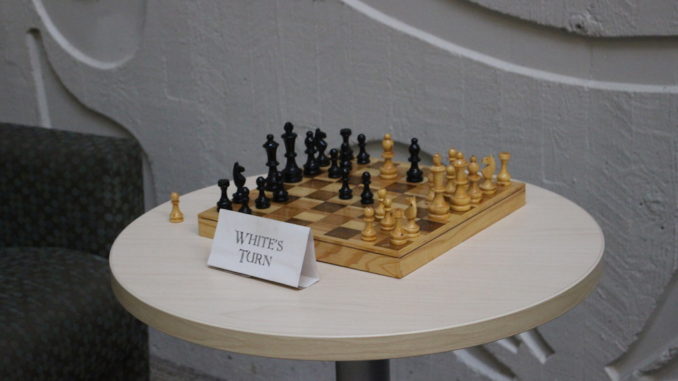
By Kendall Arlasky
The Watzek Library is home to many treasures. The ornate native wall etchings, the enchanting examples of student art and that strange wooden couch that no one seems to sit on. Despite all of these rather obvious gems, I’ve found that it’s the hidden things that make Watzek such a lovely place to sit and study. As of late, the students have been drawn to one of these hidden gems, the Watzek Library Chess Game. This chess board has impelled students to raise some serious questions. Who put it there? What is its purpose? I set out to answer these questions and get some insight into the mystery that surrounds the Watzek chessboard.
How the chess game works is that a student will make a move and then flip the card. The cards is double sided, on one side there’s the phrase “white’s turn” on the other side the card is the phrase “black’s turn.” This signals to any other student that comes across the game that it is their move and which side to play for. The anonymity of the game seems to only add to the excitement and the enigma. You never really know who your opponent is, and depending on the time you happen upon the game you could switch between players, thus becoming a traitor to your own team, although Iddo Fuhrmann ’19 indicated that sometimes it does the opposite.
“I think it creates a sense of community,” Fuhrmann said.
Despite this being the tradition, in my investigation I came across some rebels who were playing against each other.
“I’m pretty avidly in the library and I only started seeing it [the chess game] last fall,” Ahmed Gedi ’19 said.
Fuhrmann, his opponent, corroborated his statement and had some good ideas when asked about the origins of the chess table.
“Student or faculty, that’s the two options [of the chess game’s origins],” Fuhrmann said. I feel like a professor would’ve put it down if anyone [had]” The one thing these two agreed on is that it added to the atmosphere of Watzek.
“I think it, gives a nice goof off and walk around break that isn’t one that you don’t use your brain,” Gedi said. “I could easily just be watching youtube videos.”
His friend Iddo summed his thoughts by saying, nonchalantly, “it’s cute.”
My investigation so far failed to definitively answer my key questions. Did a mad-scientist professor put the board there as an intellectual test? Was it the workings of a sociology research student as part of some elaborate experiment? I went to the mothership, the library help desk, for answers. There I met Phe Crampton ’18, a student worker at the library.
“I think [the chess game] was part of this initiative that we’re trying to do,” Crampton said. “To get people to come to the library not just for studying. Like we have the chess game and we also got a lot of board games this summer. We also now have a sketchbook archive…we’re trying to make the library a more safe social space for people.” Crampton also told me that it seemed to be working.
“I see people sitting there a lot longer than they probably meant to sit there, really getting into the game,” Crampton said.
So you heard it here first folks, the Watzek chess game is here to add to our overall library experience: encouraging you to not only cram for that test that you have tomorrow, but also to sit and enjoy our beautiful library and maybe play a game or two.
Subscribe to the Mossy Log Newsletter
Stay up to date with the goings-on at Lewis & Clark! Get the top stories or your favorite section delivered to your inbox whenever we release a new issue.

No one ever suspects a librarian…but I will confess nonetheless. I’m glad to see people enjoying it!